Synthesis and Characterization of New Imidazole Phthalocyanine for Photodegradation of Micro-Organic Pollutants from Sea Water
Abstract
:1. Introduction
2. Results and Discussion
2.1. UV–Vis Spectrum of Metallophthalocyanines (M: Zn(II), Cd(II), Hg(II) and Pd(II))
2.2. FT-IR Study of Metallophthalocyanines (M: Zn(II), Cd (II), Hg(II), and Pd(II))
The Optical Band Gap of Tetra [4-(1H-imidazol-1H-imidazol-1-yl)] MPcs (M: Cd, Zn, Hg, Pd)
2.3. Preparation and Characterization of Photo-Catalytic PdPc Thin Films
2.4. Photocatalysis
2.4.1. Effect of Initial pH and Initial Concentration
2.4.2. Photocatalytic Mechanism of PdPc(Imz)
2.5. Kinetic Evaluation
2.6. Intermediates from the Photodegradation of Chlorophenols
2.6.1. Effect of Ionic Strength on Photodegradation
2.6.2. Concentration and Major Inorganic Ions Effect on Photodegradation Rate
2.7. Reusability of PdPc(Imz)/ITO/Glass Thin-Film
3. Materials and Methods
3.1. Materials
3.2. Synthesis
3.2.1. Synthesis of 4-(1H-imidazol-1-yl)phthalonitrile
3.2.2. Synthesis of the Phthalocyanines
3.3. Preparation of Thin Films and Sensitization Process
3.4. Photocatalytic Experiments
4. Conclusions
Supplementary Materials
Author Contributions
Funding
Acknowledgments
Conflicts of Interest
References
- Ge, F.; Zhu, L.; Wang, J. Distribution of chlorination products of phenols under various pHs in water disinfection. Desalination 2008, 225, 156–166. [Google Scholar] [CrossRef]
- Hugo, H.; Santiesteban, L.; Rodríguez-Vázquez, R. Fungal degradation of organochlorine pesticides. In Microbe-Induced Degradation of Pesticides, 1st ed.; Singh, S.N., Ed.; Springer International Publishing AG: Cham, Switzerland, 2017; pp. 131–149. [Google Scholar] [CrossRef]
- Igbinosa, E.O.; Odjadjare, E.E.; Chigor, V.N.; Igbinosa, I.H.; Emoghene, A.O.; Ekhaise, F.O.; Igiehon, N.O.; Idemudia, O.G. Toxicological profile of chlorophenols and their Derivatives in the Environment: The Public Health Perspective. Sci. World J. 2013, 1–11. [Google Scholar] [CrossRef] [Green Version]
- Adeola, A.O. Fate and toxicity of chlorinated phenols of environmental implications: A review. Med. Anal. Chem. Int. J. 2018, 2, 000126. [Google Scholar] [CrossRef]
- Iwase, M.; Suzuki, A.; Akiyama, T.; Oku, T. Fabrication and Characterization of Phthalocyanine-Based Organic Solar Cells. Mater. Sci. Appl. 2014, 5, 278–284. [Google Scholar] [CrossRef] [Green Version]
- Cole, A.; McIlroy, R.J.; Thorpe, S.C.; Cook, M.J.; McMurdo, J.; Ray, A.K. Substituted phthalocyanine gas sensors. Sens. Actuat. B Chem. 1993, 13, 416–419. [Google Scholar] [CrossRef]
- Ayari, S.; Saglam, F.M.; Şenkuytu, E.; Erçin, P.B.; Zorlu, Y.; Sengul, I.F.; Jamoussi, B.; Atilla, D. 3-Methylindole-substituted zinc phthalocyanines for photodynamic cancer therapy. J. Porphyr. Phthalocyanines 2019, 23, 1371–1379. [Google Scholar] [CrossRef]
- Kahouech, M.S.; Hriz, K.; Touaiti, S.; Jamoussi, B. New anthracene-based-phtalocyanine semi-conducting materials: Synthesis and optoelectronic properties. Mater. Res. Bull. 2016, 75, 144–154. [Google Scholar] [CrossRef]
- Khalil, S.; Tazarki, H.; Mehdi, S.; Souli, M.; Guasch, C.; Jamoussi, B.; Kamoun, N. Synthesis and characterization of novel 4−Tetra-4-Tolylsulfonyl ZnPc thin films for optoelectronic applications. Appl. Surf. Sci. 2017, 421, 205–212. [Google Scholar] [CrossRef]
- Durmuş, M.; Lebrun, C.; Ahsen, V. Synthesis and characterization of novel liquid and liquid crystalline phthalocyanines. J. Porphyr. Phthalocyanines 2004, 10, 1175–1186. [Google Scholar] [CrossRef]
- Hoffmann, M.R.; Hong, A.P.K. Catalytic oxidation of reduced sulfur compounds by homogeneous and heterogeneous Co(II) phthalocyanine complexes. Sci. Total Environ. 1987, 64, 99–115. [Google Scholar] [CrossRef]
- Naeimi, H.; Rahmatinejad, S. Nano magnetite supported phthalocyanine complexes of Cu(II) and Fe(II) as new heterogeneous effective catalysts for synthesis of β-amido ketones. J. Coord. Chem. 2018, 71, 4210–4227. [Google Scholar] [CrossRef]
- Chatti, I.; Ghorbel, A.; Grange, P.; Colin, J.M. Oxidation of mercaptans in light oil sweetening by cobalt(II)phthalocyanine–hydrotalcite catalysts. Catal. Today 2002, 75, 113–117. [Google Scholar] [CrossRef]
- Temizel, S.; Çanak, T.Ç.; Sevim, A.M. Novel polymers with cobalt(II)phthalocyanine moieties as effective heterogeneous photocatalysts for visible-light-driven photodegradation of organic dyes in aqueous solutions. J. Photochem. Photobiol. A 2020, 401, 112741. [Google Scholar] [CrossRef]
- Que, L.; Tolman, W.B. Biologically inspired oxidation catalysis. Nature 2008, 455, 333–340. [Google Scholar] [CrossRef]
- Mangematin, S.; Sorokin, A.B. Synthesis and catalytic properties of a novel phthalocyanine covalently grafted onto silica. J. Porphyr. Phthalocyanines 2001, 5, 674–680. [Google Scholar] [CrossRef]
- Sehlotho, N.; Nyokong, T. Catalytic activity of iron and cobalt phthalocyanine complexes towards the oxidation of cyclohexene using tert-butylhydroperoxide and chloroperoxybenzoic acid. J. Mol. Catal. A Chem. 2004, 209, 51–57. [Google Scholar] [CrossRef]
- Zalomaeva, O.V.; Ivanchikova, I.D.; Kholdeeva, O.A.; Sorokin, A.B. Kinetics and mechanism of the oxidation of alkyl substituted phenols and naphthols with tBuOOH in the presence of supported iron phthalocyanine. New J. Chem. 2009, 33, 1031–1037. [Google Scholar] [CrossRef]
- Meunier, B.; Sorokin, A. Oxidation of Pollutants Catalyzed by Metallophthalocyanines. Acc. Chem. Res. 1997, 30, 470–476. [Google Scholar] [CrossRef]
- Sorokin, A.; Fraisse, L.; Rabion, A.; Meunier, B. Metallophthalocyanine-catalyzed oxidation of catechols by H2O2 and its surrogates. J. Mol. Catal. A Chem. 1997, 117, 103–114. [Google Scholar] [CrossRef]
- Hage, R.; Lienke, A. Applications of Transition-Metal Catalysts to Textile and Wood-Pulp Bleaching. Angew. Chem. Int. Ed. 2006, 45, 206–222. [Google Scholar] [CrossRef]
- Sorokin, A.; Meunier, B.; Séris, J.L. Efficient oxidative dechlorination and aromatic ring cleavage of chlorinated phenols catalyzed by iron sulfophthalocyanine. Science 1995, 268, 1163–1166. [Google Scholar] [CrossRef] [PubMed]
- Sorokin, A.; Meunier, B. Oxidative degradation of polychlorinated phenols catalyzed by metallosulfophthalocyanines. Chem. Eur. J. 1996, 2, 1308–1317. [Google Scholar] [CrossRef]
- Sorokin, A.; De Suzzoni-Dezard, S.; Poullain, D.; Noėl, J.B.; Meunier, B. CO2 as the Ultimate Degradation Product in the H2O2 Oxidation of 2,4,6-Trichlorophenol Catalyzed by IronTetrasulfophthalocyanine. J. Am. Chem. Soc. 1996, 118, 7410–7411. [Google Scholar] [CrossRef]
- Hadasch, A.; Sorokin, A.; Rabion, A.; Fraisse, L.; Meunier, B. Oxidation of 2,4,6-trichlorophenol (TCP) catalyzed by iron tetrasulfophthalocyanine (FePcS) supported on a cationic ion-exchange resin. Bull. Soc. Chim. Fr. 1997, 134, 1025–1032. [Google Scholar] [CrossRef]
- Smida, H.B.Y.; Jamoussi, B. Degradation of Nitroaromatic Pollutant by Titanium dioxide/Zinc Phthalocyanine: Study of the Influencing Factors. J. Appl. Chem. 2012, 2, 11–17. [Google Scholar] [CrossRef]
- Smida, H.B.Y.; Beicheickh, M.; Jamoussi, B. Degradation of Hydroxytyrosol in Olive Oil Mill Wastewaters using Thermosensitive Zinc Phthalocyanine-Modified Titanium Dioxide. J. Residuals Sci. Technol. 2013, 10, 47–54. [Google Scholar]
- Mele, G.; Del Sole, R.; Vasapollo, G.; García-López, E.; Palmisano, M.; Schiavello, M. Photocatalytic degradation of 4-nitrophenol in aqueous suspension by using polycrystalline TiO2 impregnated with functionalized Cu(II)–porphyrin or Cu(II)–phthalocyanine. J. Catal. 2003, 217, 334–342. [Google Scholar] [CrossRef]
- El-Khouly, M.E.; Rogers, L.M.; Zandler, M.E.; Suresh, G.; Fujitsuka, M.; Ito, O.; D’Souza, F. Studies on Intra-Supramolecular and Intermolecular Electron-Transfer Processes between Zinc Naphthalocyanine and Imidazole-Appended Fullerene. Chem. Phys. Chem. 2003, 4, 474–481. [Google Scholar] [CrossRef]
- Derry, G.N.; Kern, M.E.; Worth, E.H. Recommended values of clean metal surface work functions. J. Vac. Sci. Technol. A 2015, 33, 060801. [Google Scholar] [CrossRef]
- Kashiwaya, S.; Morasch, J.; Streibel, V.; Toupance, T.; Jaegermann, W.; Klein, A. The Work Function of TiO2. Surfaces 2018, 1, 73–89. [Google Scholar] [CrossRef] [Green Version]
- Xu, J.; Zhao, L.; Hou, W.; Guo, H.; Zhang, H. Dependence of morphology, substrate and thickness of iron phthalocyanine thin films on the photocatalytic degradation of rhodamine B dye. Chem. Pap. 2018, 72, 2327–2337. [Google Scholar] [CrossRef]
- Chakane, S.; Datir, A.; Koinkar, P. Spin coated unsubstituted copper phthalocyanine thin films for nitrogen dioxide sensors. Mod. Phys. Lett. B 2015, 29, 1540032. [Google Scholar] [CrossRef]
- Al-Raqa, S.Y.; Solieman, A.S.; Joraid, A.A.; Alamri, S.N.; Moussa, Z.; Aljuhani, A. Preparation and optical properties of novel symmetrical hexadecachlorinatedphthalocyaninato zinc (II) spin coated thin films. Polyhedron 2008, 27, 1256–1261. [Google Scholar] [CrossRef]
- Critchley, S.M.; Willis, M.R. Deposition of thin phthalocyanine films by spin coating. Int. J. Electron. 1994, 76, 809–814. [Google Scholar] [CrossRef]
- Karimi, A.R.; Khodadadi, A. Synthesis and solution properties of new metal-free and metallo-phthalocyanines containing four bis(indol-3-yl)methane groups. Tetrahedron Lett. 2012, 53, 5223–5226. [Google Scholar] [CrossRef]
- De la Torre, G.; Nicolau, M.; Torres, T. Phtalocyanine: Synthesis, supramolecular organization and physical properties. In Supramolecular Photosensitive and Electroactive Materials; Singh, S.N., Ed.; Stanford Scientific Corporation: Los Angeles, CA, USA, 2001; pp. 1–111. [Google Scholar]
- Claessens, C.G.; González-Rodríguez, D.; Torres, T. Subphthalocyanines: Singular nonplanar aromatic compounds synthesis, reactivity, and physical properties. Chem. Rev. 2002, 102, 835–853. [Google Scholar] [CrossRef]
- Leznoff, C.C.; Vigh, S.; Svirskaya, P.I.; Greenberg, S.; Drew, D.M.; Ben-Hur, E.; Rosenthal, I. Synthesis and photocytotoxicity of some new substituted phthalocyanines. Photochem. Photobiol. 1989, 49, 279–284. [Google Scholar] [CrossRef] [Green Version]
- Nyokong, T. Effects of substituents on the photochemical and photophysical properties of main group metal phthalocyanines. Coord. Chem. Rev. 2007, 251, 1707–1722. [Google Scholar] [CrossRef]
- Lokesh, K.S.; Adriaens, A. Synthesis and characterization of Tetra-substituted palladium phthalocyanine complexes. Dye. Pigm. 2013, 96, 269–277. [Google Scholar] [CrossRef]
- Raciti, R.; Bahariqushchi, R.; Summonte, C.; Aydinli, A.; Terrasi, A.; Mirabella, S. Optical band gap of semiconductor nanostructures: Methods for experimental data analysis. J. Appl. Phys. 2017, 121, 234304. [Google Scholar] [CrossRef]
- Feng, Y.; Lin, S.; Huang, S.; Shrestha, S.; Conibeer, G. Can Tauc plot extrapolation be used for direct-band-gap semiconductor nanocrystals? J. Appl. Phys. 2015, 117, 125701. [Google Scholar] [CrossRef]
- Murphy, A.B. Band-gap determination from diffuse reflectance measurements of semiconductor films, and application to photoelectrochemical water-splitting. Sol. Energy Mater. Sol. Cells. 2007, 91, 1326–1337. [Google Scholar] [CrossRef]
- Enderby, J.E.; Barnes, A.C. Liquid semiconductors. Rep. Prog. Phys. 1990, 53, 85. [Google Scholar] [CrossRef]
- El-Nhass, M.M.; Soliman, H.S.; Metwally, H.S.; Farid, A.M.; Farag, A.A.M.; El Shazly, A.A. Optical properties of evaporated iron phthalocyanine (FePc) thin films. J. Opt. 2001, 30, 121–129. [Google Scholar] [CrossRef]
- Hamam, K.J.; Alomari, M.I. A study of the optical band gap of zinc phthalocyanine nanoparticles using UV–Vis spectroscopy and DFT function. Appl. Nanosci. 2017, 7, 261–268. [Google Scholar] [CrossRef] [Green Version]
- Tauc, J.; Grigorovici, R.; Vancu, A. Optical Properties and Electronic Structure of Amorphous Germanium. Phys. Status Solidi B 1966, 15, 627–637. [Google Scholar] [CrossRef]
- Timoumi, A.; Al Turkestani, M.K.; Alamri, S.N.; Alamri, H.; Ouerfelli, J.; Jamoussi, B. Synthesis and characterization of thin films of palladium (II) phthalocyanine and its derivatives using the thermal evaporation technique. J. Mater. Sci. Mater. Electron. 2017, 28, 7480–7488. [Google Scholar] [CrossRef]
- Ghosh, M.; Jana, S.C. Fabrication of Hollow and Porous Tin-Doped Indium Oxide Nanofibers and Microtubes via a Gas Jet Fiber Spinning Process. Materials 2020, 13, 1539. [Google Scholar] [CrossRef] [Green Version]
- Xue, M.; Jiang, Z.; Li, W.; Bi, G.; Ou, J.; Wang, F.; Li, C. Self-assembly growth and electron work function of copper phthalocyanine films on indium tin oxide glass. Appl. Surf. Sci. 2012, 258, 3373–3377. [Google Scholar] [CrossRef]
- Kulkarni, A.K.; Schulz, K.H.; Lim, T.S.; Khan, M. Dependence of the sheet resistance of indium-tin-oxide thin films on grain size and grain orientation determined from X-ray diffraction techniques. Thin Solid Film. 1999, 345, 273–277. [Google Scholar] [CrossRef]
- Griscom, D.L. Optical Properties and Struct. Defects Silica Glass. J. Ceram. Soc. Jpn. 1991, 99, 923–942. [Google Scholar] [CrossRef]
- Ahn, S.; Jeong, S.H.; Han, T.H.; Lee, T.W. Conducting Polymers as Anode Buffer Materials in Organic and Perovskite Optoelectronics. Adv. Opt. Mater. 2016, 1–24. [Google Scholar] [CrossRef]
- Kim, H.K.; Kang, S.J. Effective Work Function Control of Indium-tin-oxide Electrodes. J. Korean Phys. Soc. 2011, 59, 2655–2657. [Google Scholar] [CrossRef]
- Tadjarodi, A.; Hossein, A.; Khavar, C.; Imani, M. The removal of 2,4-dichlorophenol under visible light irradiation by silver indium sulfide nanoparticles synthesized by microwave. Curr. Chem. Lett. 2013, 2, 77–84. [Google Scholar] [CrossRef]
- Pirbazari, A.E. Photocatalytical treatment of synthetic wastewater containing chlorophenols by TiO2 nanoparticles sensitized with cobalt phthalocyanine under visible light. J. Chem. Eng. Process. Technol. 2017, 8. [Google Scholar] [CrossRef]
- Hajimohammadi, M.; Sereshk, A.V.; Schwarzinger, C.; Knör, G. Suppressing Effect of 2-Nitrobenzaldehyde on Singlet Oxygen Generation, Fatty Acid Photooxidation, and Dye-Sensitizer Degradation. Antioxidants 2018, 7, 194. [Google Scholar] [CrossRef] [Green Version]
- Czaplicka, M.; Czaplicki, A. Photodegradation of 2,3,4,5-tetrachlorophenol in water/methanol mixture. J. Photochem. Photobiol. A 2006, 178, 90–97. [Google Scholar] [CrossRef]
- Boule, P.; Guyon, C.; Tissot, A.; Lemaire, J. Specific phototransformation of xenobiotic compounds: Chlorobenzenes and halophenols. In Photochemistry of Environmental Aquatic Systems; Zika, R.G., Cooper, W.J., Eds.; American Chemical Society: Washington, DC, USA, 1987; Volume 327, pp. 10–26. [Google Scholar]
- D’Oliveira, J.C.; Al-Sayyed, G.; Pichat, P. Photodegradation of 2- and 3-Chlorophenol in TiO2 Aqueous Suspensions. Environ. Sci. Technol. 1990, 24, 990–996. [Google Scholar] [CrossRef]
- Bashiri, H.; Rafiee, M. Kinetic Monte Carlo simulation of 2,4,6-thrichloro phenol ozonation in the presence of ZnO nanocatalyst. J. Saudi Chem. Soc. 2016, 20, 474–479. [Google Scholar] [CrossRef] [Green Version]
- Saritha, P.; Raj, D.S.S.; Aparna, C.; Laxmi, P.N.V.; Himabindu, V.; Anjaneyulu, Y. Degradative oxidation of 2,4,6 trichlorophenol using advanced oxidation processes a comparative study. Water Air Soil Pollut. 2009, 200, 169–179. [Google Scholar] [CrossRef]
- Chaliha, S.; Bhattacharyya, K.G. Wet oxidative method for removal of 2,4,6-trichlorophenol in water using Fe(III), Co(II), Ni(II) supported MCM41 catalysts. J. Hazard. Mater. 2008, 150, 728–736. [Google Scholar] [CrossRef] [PubMed]
- Ji, H.; Chang, F.; Hu, X.; Qin, W.; Shen, J. Photocatalytic degradation of 2,4,6-trichlorophenol over g-C3N4 under visible light irradiation. Chem. Eng. J. 2013, 218, 183–190. [Google Scholar] [CrossRef]
- Mezger, E.M.; De Nooijer, L.J.; Boer, W.; Brummer, G.J.A.; Reichart, G.J. Salinity controls on Na incorporation in Red Sea planktonic foraminifera. Paleoceanogr. Paleoclimatol. 2016, 31, 1562–1582. [Google Scholar] [CrossRef] [Green Version]
- Buxter, G.V.; Bydder, M.; Salmon, G.A.; Williams, J.E. The reactivity of chlorine atoms in aqueous solution. Part III. The reactions of Cl• with solutes. Phys. Chem. Chem. Phys. 2000, 2, 237–245. [Google Scholar] [CrossRef]
- Masoud, M.S.; Abdel-Halim, A.M.; El Ashmawy, A.A. Seasonal variation of nutrient salts and heavy metals in mangrove (Avicennia marina) environment, Red Sea, Egypt. Environ. Monit. Assess. 2019, 191, 425. [Google Scholar] [CrossRef] [PubMed]
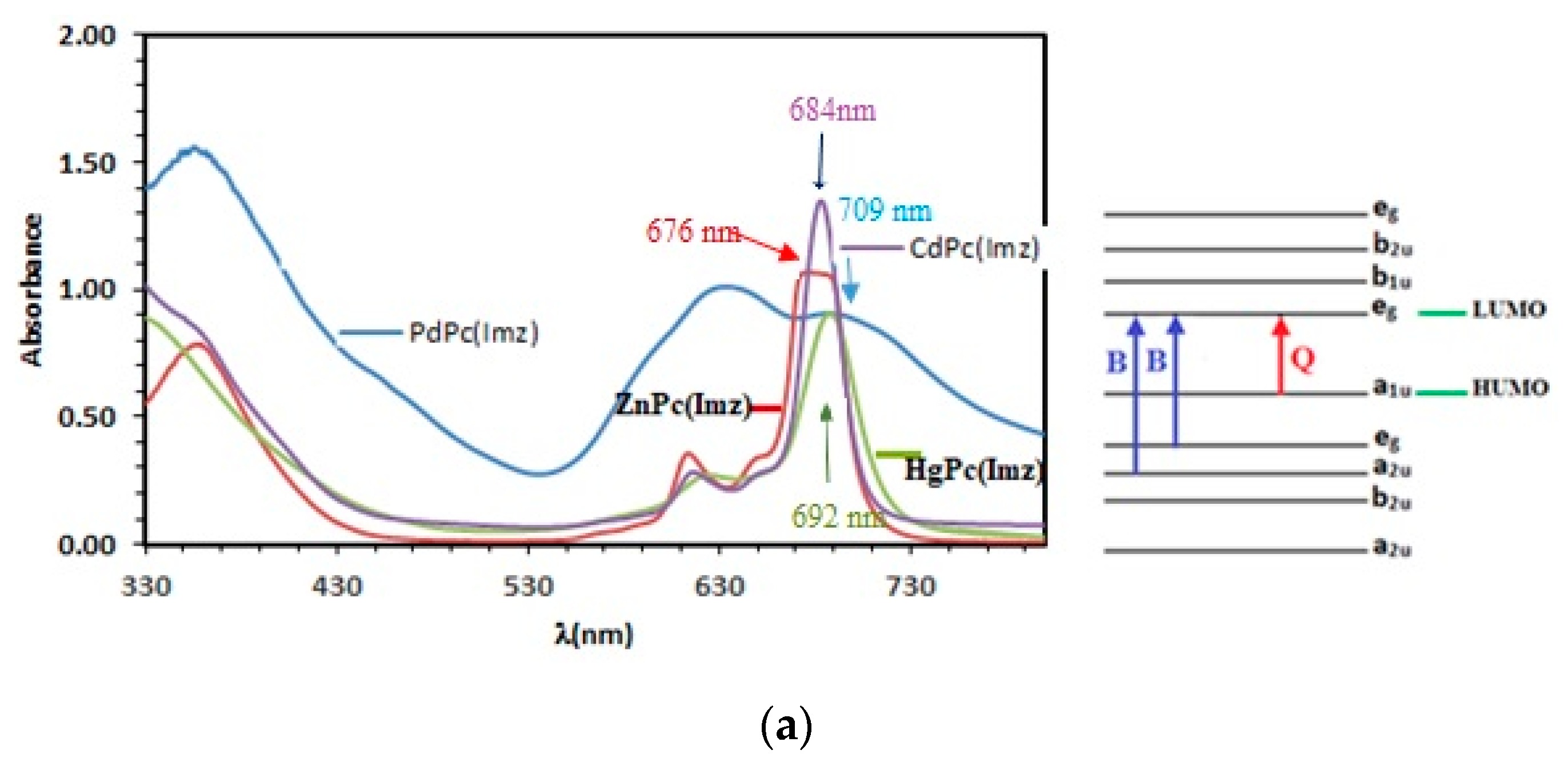

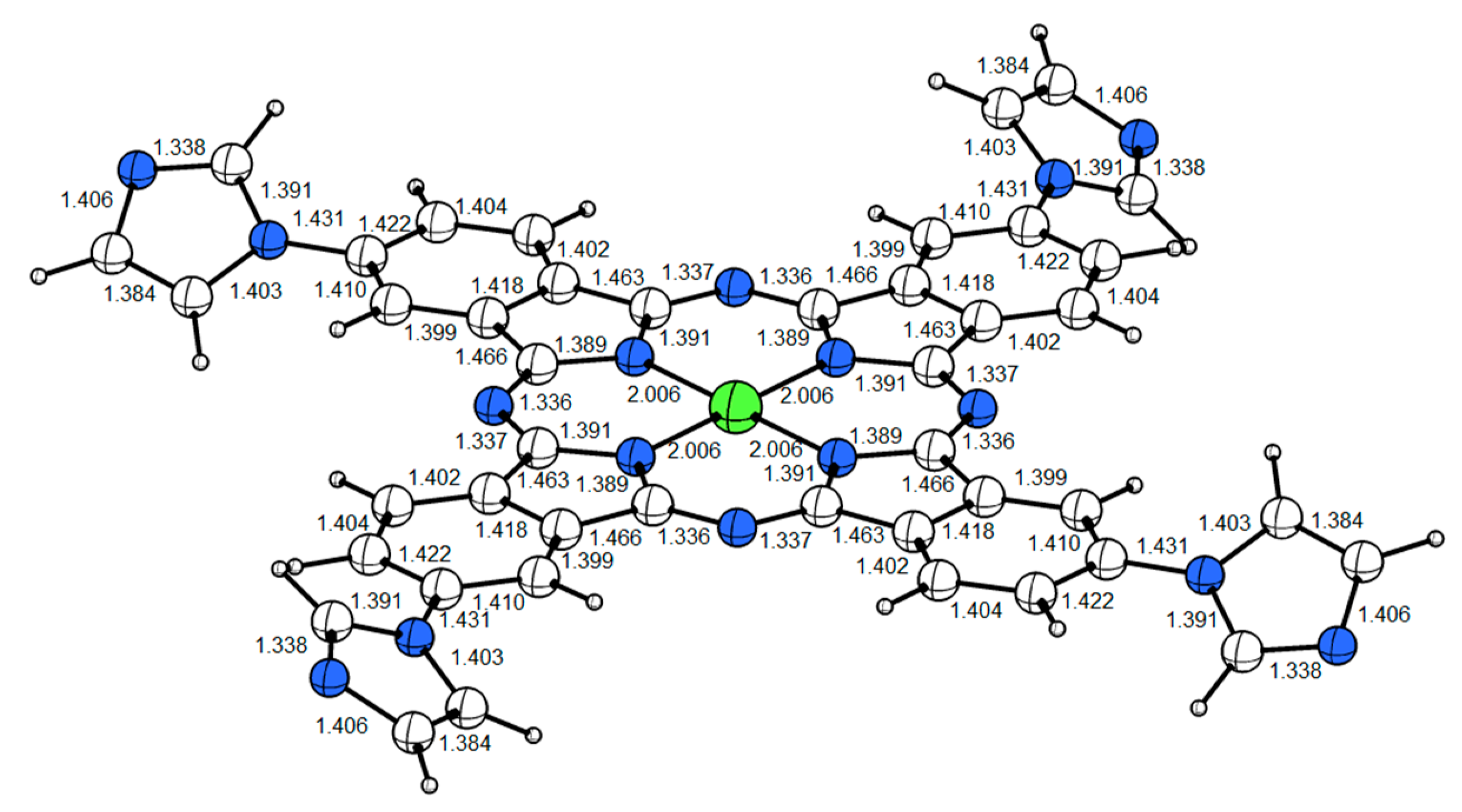
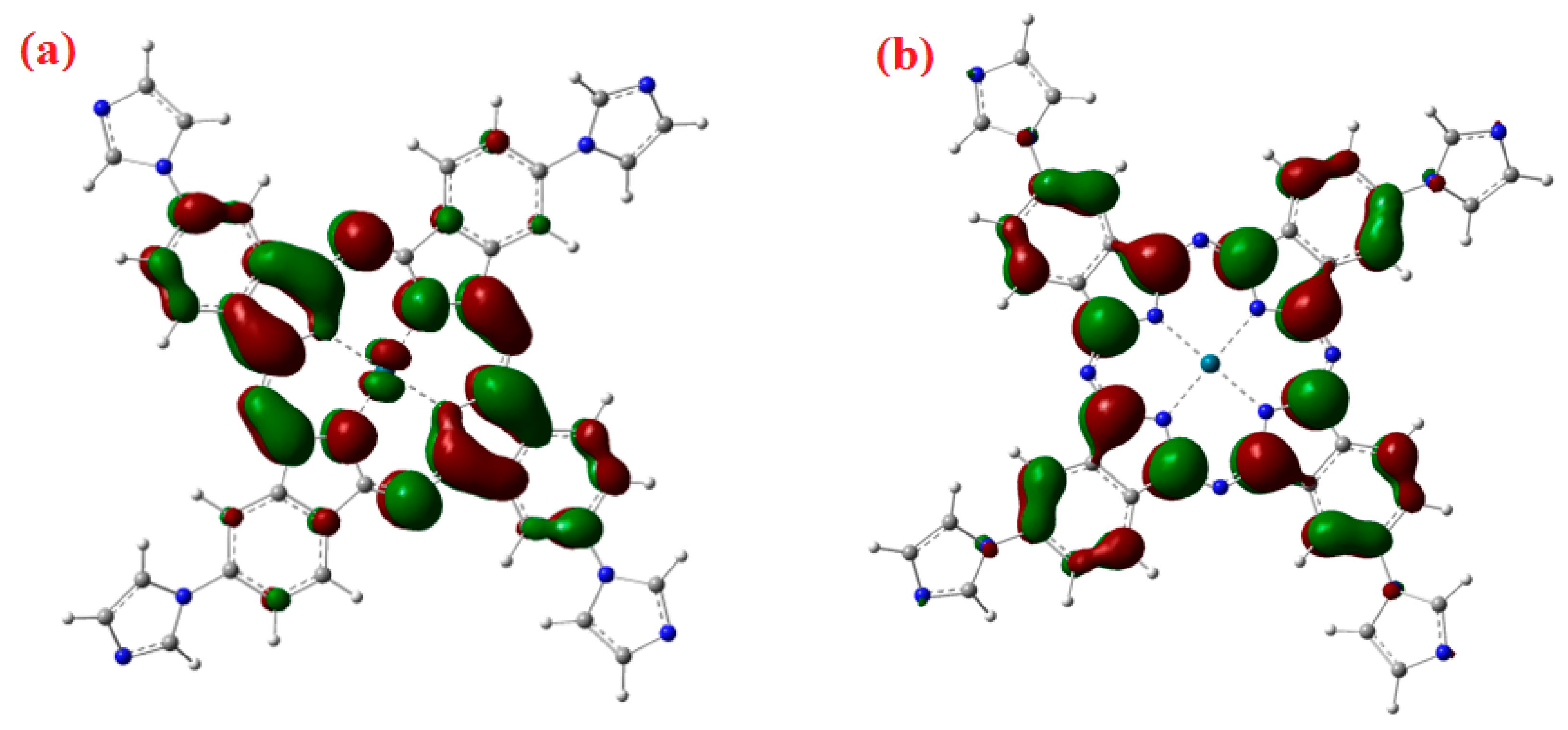

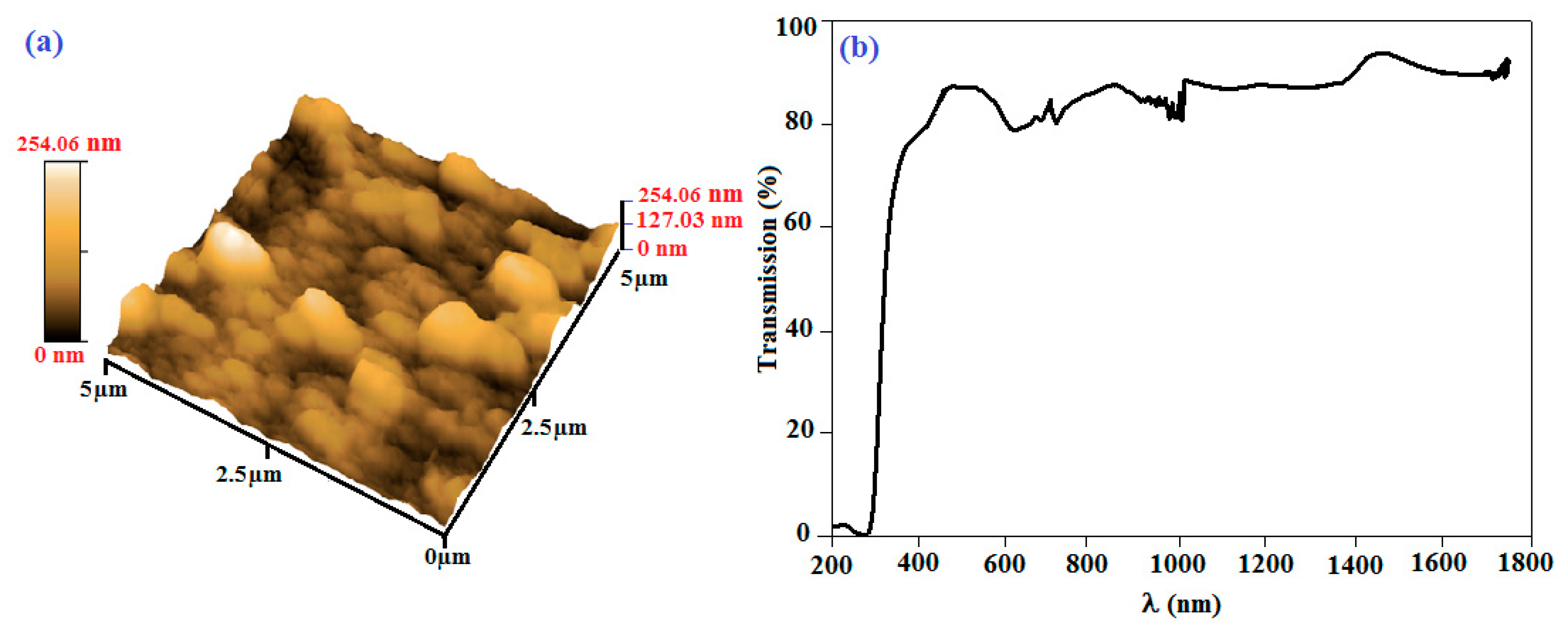
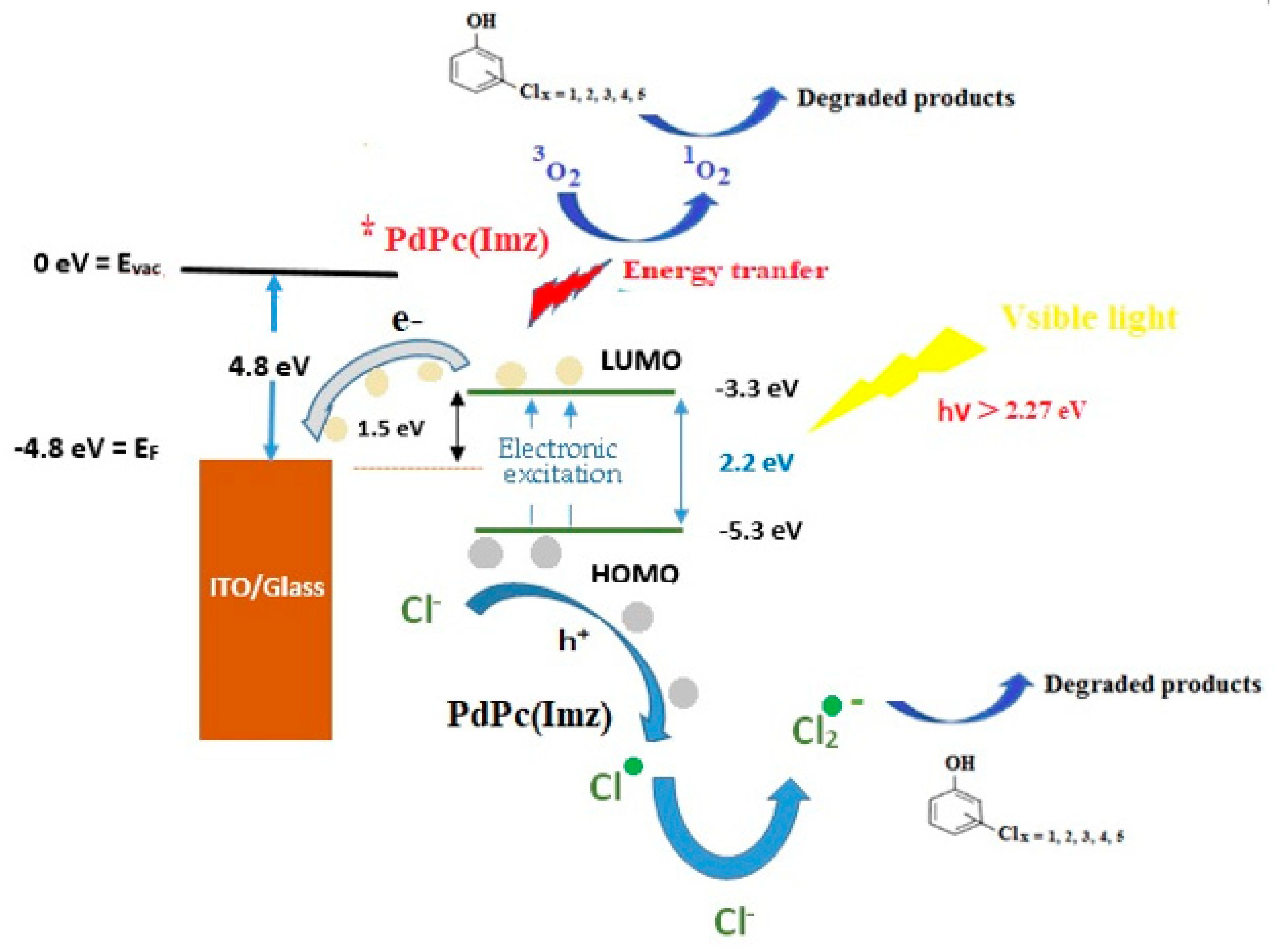
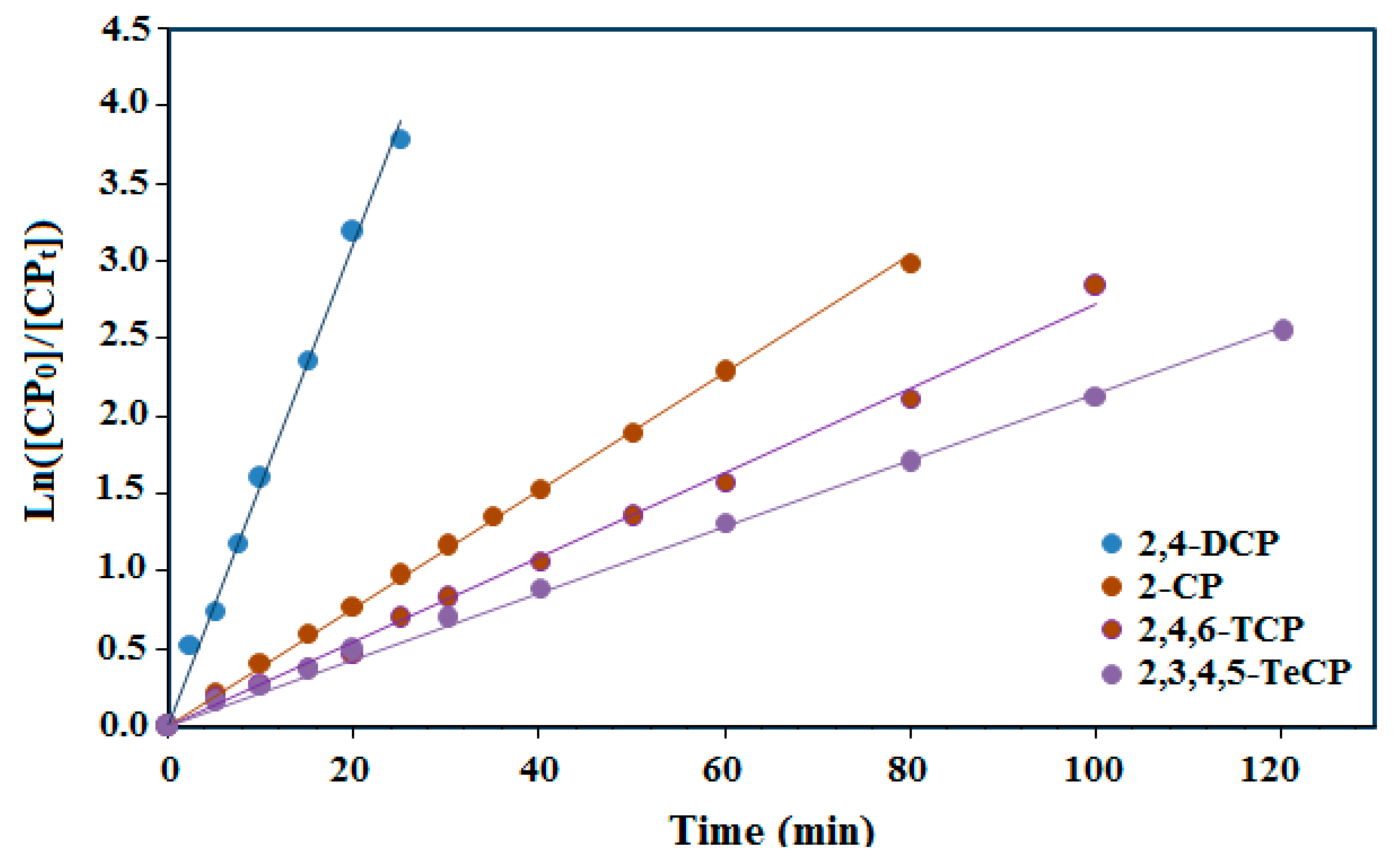
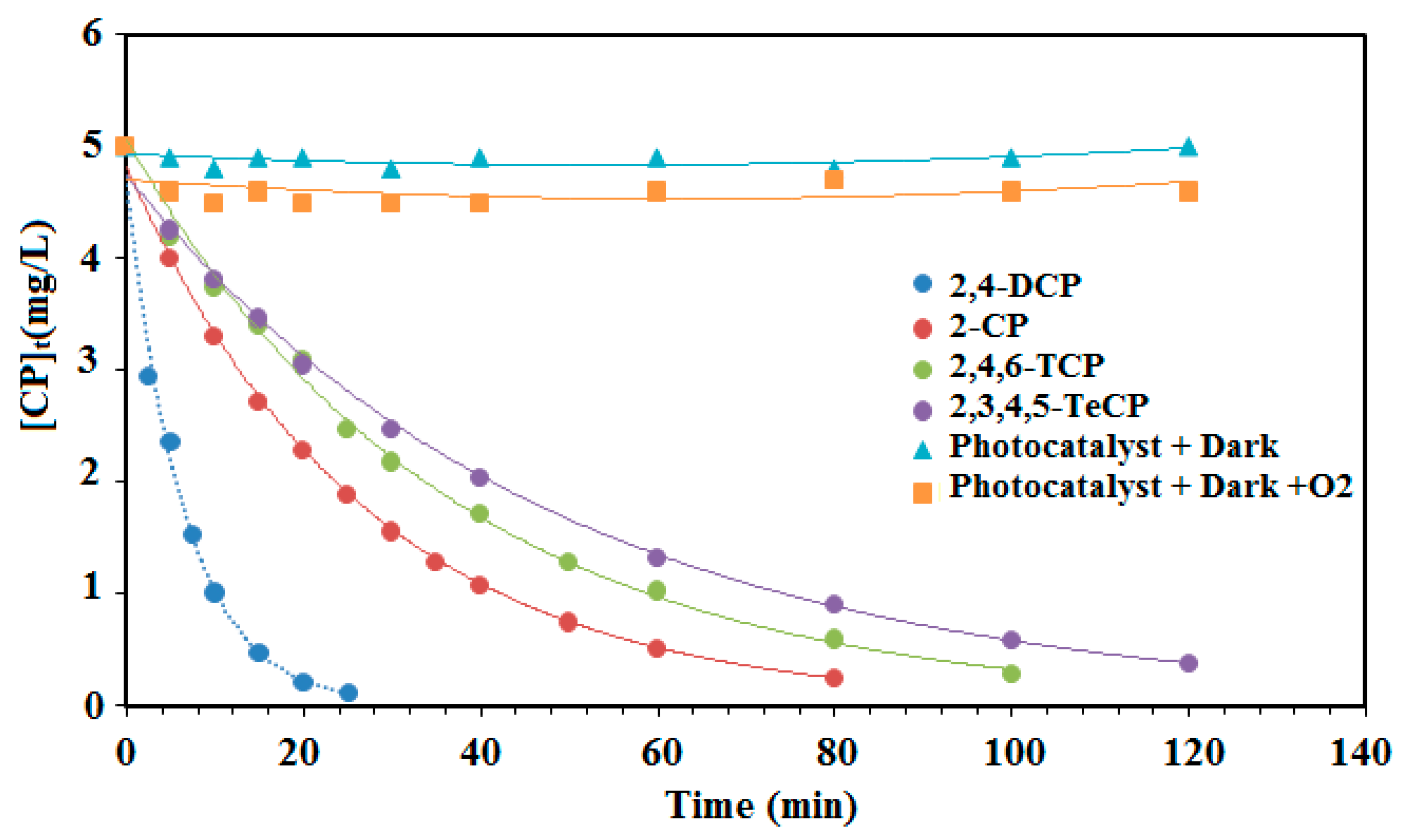
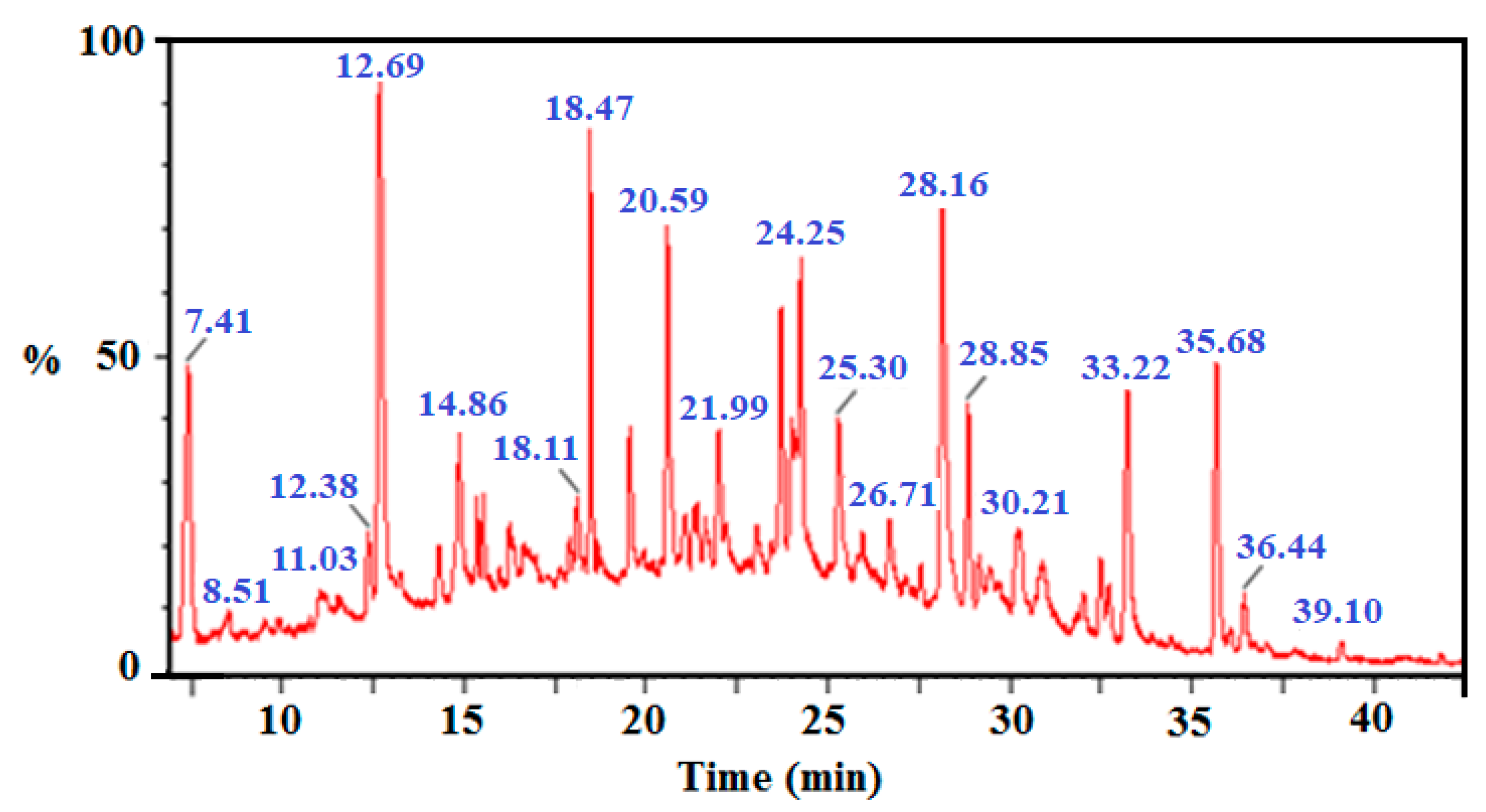
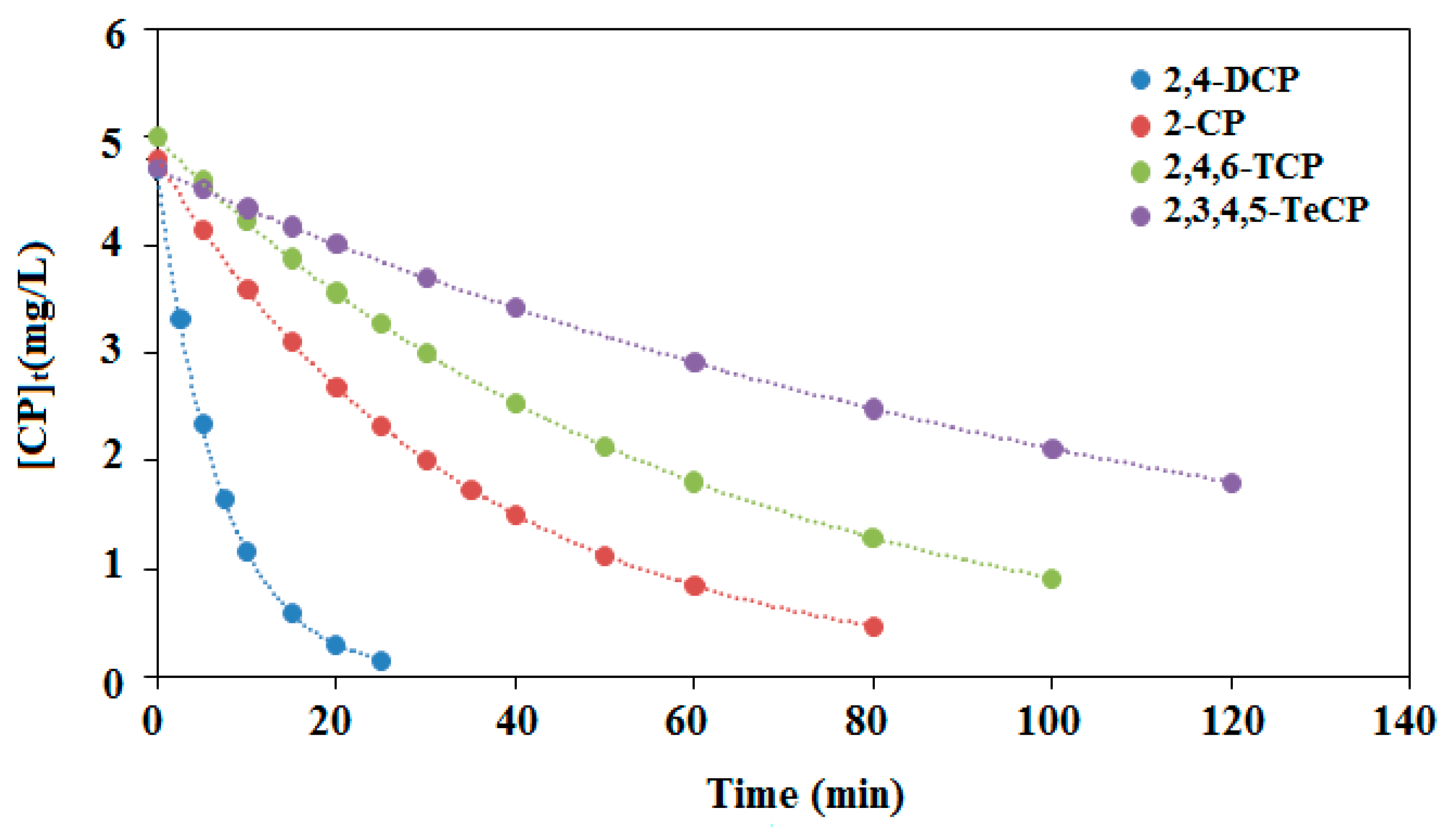






| Optical Band Gaps | ||||
|---|---|---|---|---|
| MPc(Imz) | HgPc(Imz) | CdPc(Imz) | ZnPc(Imz) | PdPc(Imz) |
| Optical band gap (eV) | 2.94 | 2.87 | 2.83 | 2.76 |
| Pollutant | kobs (min−1) × 103 | r0 (µmol min−1) | t1/2 (min) | t99% (min) | R2 |
|---|---|---|---|---|---|
| 2-CP | 38 | 1.26 | 18.24 | 121.18 | 0.9989 |
| 2,4-DCP | 156 | 3.10 | 4.44 | 29.52 | 0.9968 |
| 2,4,6-TCP | 27 | 0.67 | 25.67 | 170.56 | 0.9966 |
| 2,3,4,5-TeCP | 21 | 0.40 | 33.00 | 219.29 | 0.9974 |
© 2020 by the authors. Licensee MDPI, Basel, Switzerland. This article is an open access article distributed under the terms and conditions of the Creative Commons Attribution (CC BY) license (http://creativecommons.org/licenses/by/4.0/).
Share and Cite
Jamoussi, B.; Chakroun, R.; Timoumi, A.; Essalah, K. Synthesis and Characterization of New Imidazole Phthalocyanine for Photodegradation of Micro-Organic Pollutants from Sea Water. Catalysts 2020, 10, 906. https://doi.org/10.3390/catal10080906
Jamoussi B, Chakroun R, Timoumi A, Essalah K. Synthesis and Characterization of New Imidazole Phthalocyanine for Photodegradation of Micro-Organic Pollutants from Sea Water. Catalysts. 2020; 10(8):906. https://doi.org/10.3390/catal10080906
Chicago/Turabian StyleJamoussi, Bassem, Radhouane Chakroun, Abdelmajid Timoumi, and Khaled Essalah. 2020. "Synthesis and Characterization of New Imidazole Phthalocyanine for Photodegradation of Micro-Organic Pollutants from Sea Water" Catalysts 10, no. 8: 906. https://doi.org/10.3390/catal10080906






